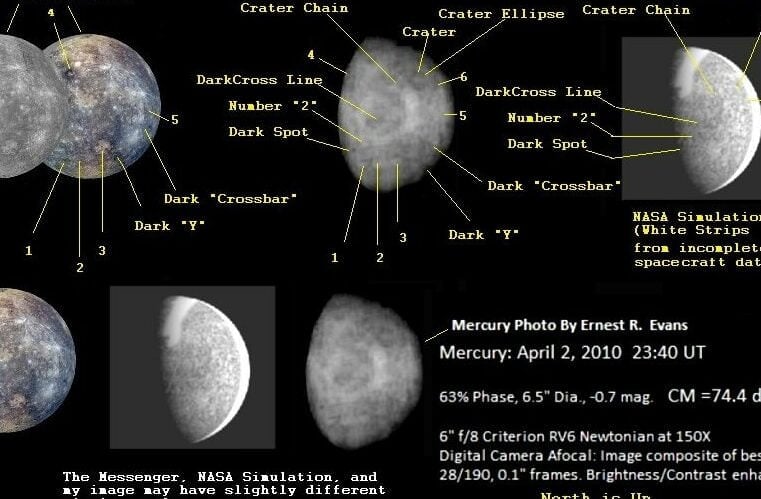What is the size of this celestial body? Actually, you are looking at a genuine speck, as Mercury is the tiniest planet in our solar system. It is truly remarkable how this world has managed to secure the second spot in terms of density. The liquid core encompasses 42% of its overall volume. Let’s delve deeper into the internal composition of Mercury.
The composition of Mercury
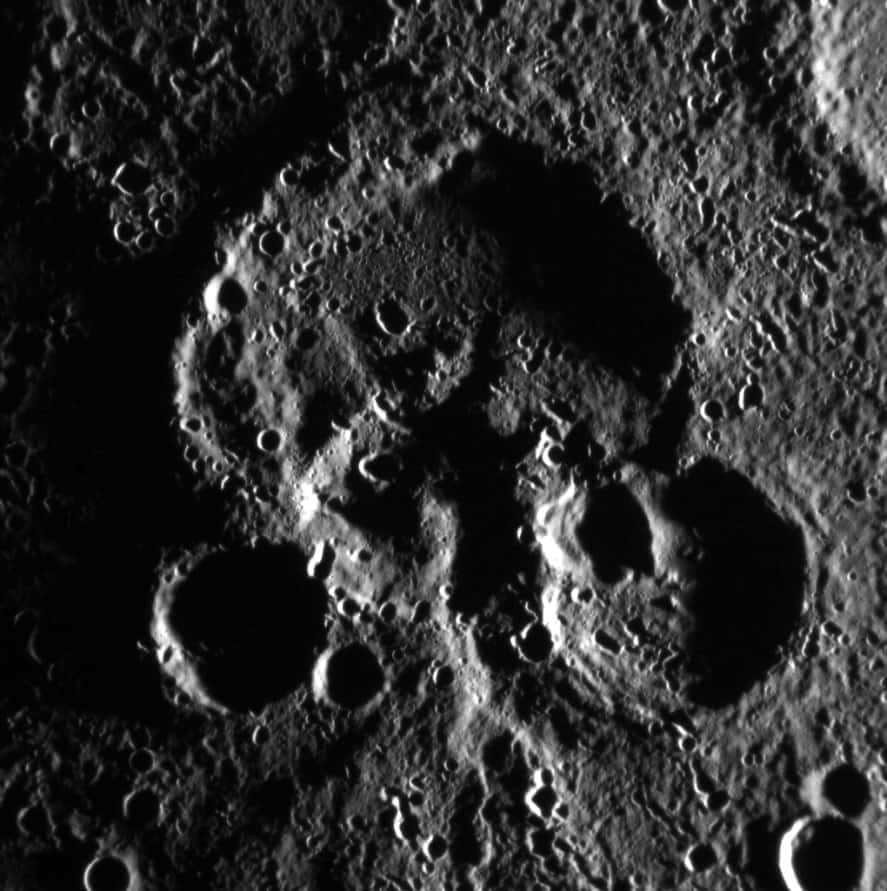

What you see here is the surface of Mercury, photographed from an altitude of 450 kilometers.
The surface is covered with craters and provides evidence of past geological activity. An era of intense asteroid bombardment concluded 3.8 billion years ago. Some of the impact craters became filled with molten lava, which then solidified and caused the surface to contract, resulting in cracks and ridges. The volcanic activity on Mercury ceased approximately 700-800 years ago. Interestingly, the structure of Mercury is similar to that of the Moon (in fact, photos of the surface can sometimes be mistaken for each other).

Mercury’s Structure: Diameter
The diameter of Mercury is 4879.4 kilometers, which is only 38% of the Earth’s diameter. In comparison, Jupiter’s moon Ganymede (5268 km) and Saturn’s moon Titan (5152 km) are larger in size.
Mercury’s radius measures 2439.7 km.
Mercury’s Structure: Circumference
The circumference of Mercury is 15329 kilometers, which is the distance you would need to travel if the planet’s equator was flat.
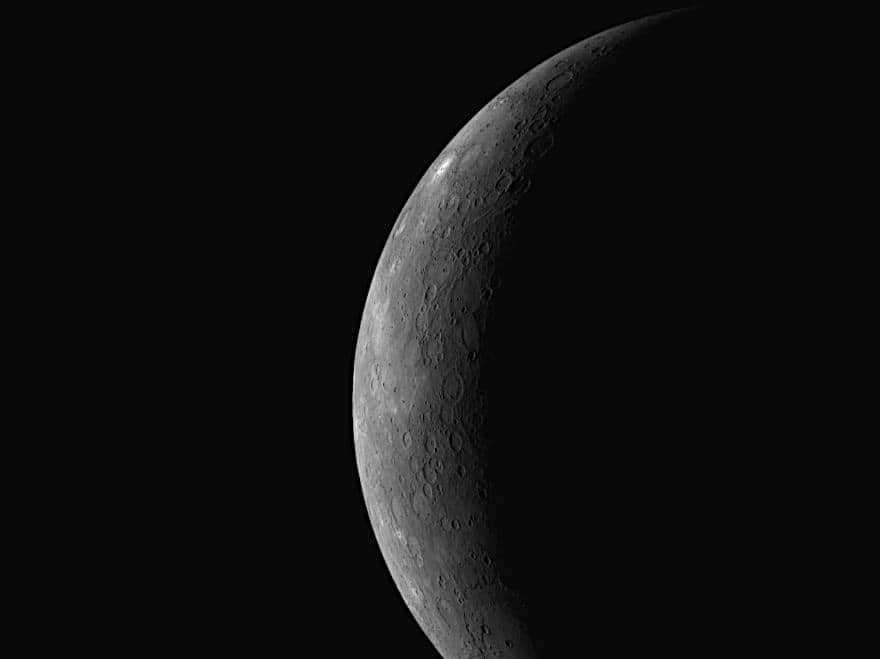
Many celestial bodies in our solar system take on the shape of flattened spheroids. The distance from the center to the poles is greater on planets with faster rotation periods. However, due to its slower revolution, Mercury maintains a consistent circumference.
The Composition of Mercury: Volume of the Planet
Mercury has a total volume of 6.083 x 10 10 10 km 3 . For comparison, this is only 5.4% of Earth’s volume. In terms of size, the Sun is 240.5 million times larger. Therefore, Mercury can be considered a small world in comparison.
The core of Mercury measures 3,600 kilometers in diameter. It exists in a molten state and is primarily composed of iron. As a result of its motion, a weak magnetic field is generated. The image below provides a visual comparison between the sizes of Earth and Mercury.
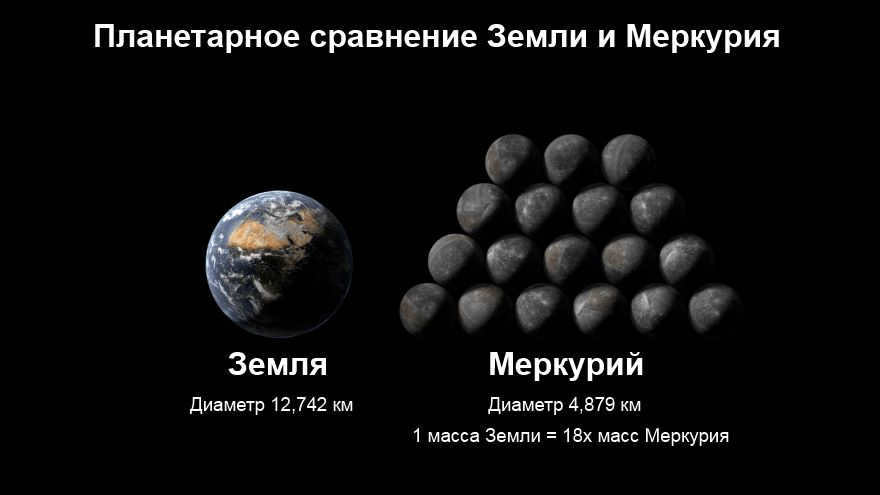
It is speculated that in the previous era, the planet possessed a larger size and a greater mass. It is highly probable that a substantial celestial object collided with Mercury in the past, resulting in the removal of a significant portion of its surface layer. This phenomenon can also account for the notably substantial proportion of the planet’s core volume, which comprises 42% of the overall mass.
A proficient tarot reader will provide answers to the following inquiries:
What lies in store for your future? How will your relationships evolve? What is the optimal course of action to take?

Mercury’s Composition: Mass
The planet possesses a weight of 3.30 x 10 23 kg (which accounts for 5.5% of Earth’s mass). Despite its small size, it is important to note that Mercury ranks second in terms of density.

An artistic representation of the MESSENGER spacecraft circling around Mercury.
Mercury consists of 70% metal and 30% silicate. It is hypothesized that in the past, Mercury had an equal distribution of these materials, but this changed as a result of a collision with a celestial object. A similar event occurred on Earth, leading to the formation of our moon. It is also possible that Mercury formed prior to the stabilization of solar energy. In this scenario, the planet’s surface would have simply vaporized due to the significantly higher solar temperatures.
Mercury’s gravitational force is only 38% of that of Earth. Interestingly, if Mercury were to have the same size as Earth, its density would double as well. However, at present, the conditions on Mercury are more similar to those on the moon. If you were on the surface of Mercury, your weight would decrease from 100 kg to 38 kg. This could be considered an extreme method for those who aspire to lose weight. Additionally, you would have the opportunity to become a high jump record holder on Mercury. The current world record of 2.43 meters would increase to 6.4 meters.
In order to escape the gravitational pull of Mercury, you would need to accelerate to 4.3 km/s, while on Earth the required acceleration is 11.2 km/s.
The Density of Mercury and its Internal Structure
As we have previously mentioned, Mercury has the second highest density among all planets. Its density of 5.427 g/cm3 is only slightly lower than that of Earth, which is 5.515 g/cm3. If we exclude the effects of gravity, Mercury would actually have the highest density.
Mercury is classified as a terrestrial planet, meaning it is part of the inner system. The density information has allowed scientists to gain insights into its internal structure. It is evident that there is no significant compression occurring within the planet, and its core contains a substantial amount of iron. The accompanying photo provides a visual representation of Mercury’s structure.
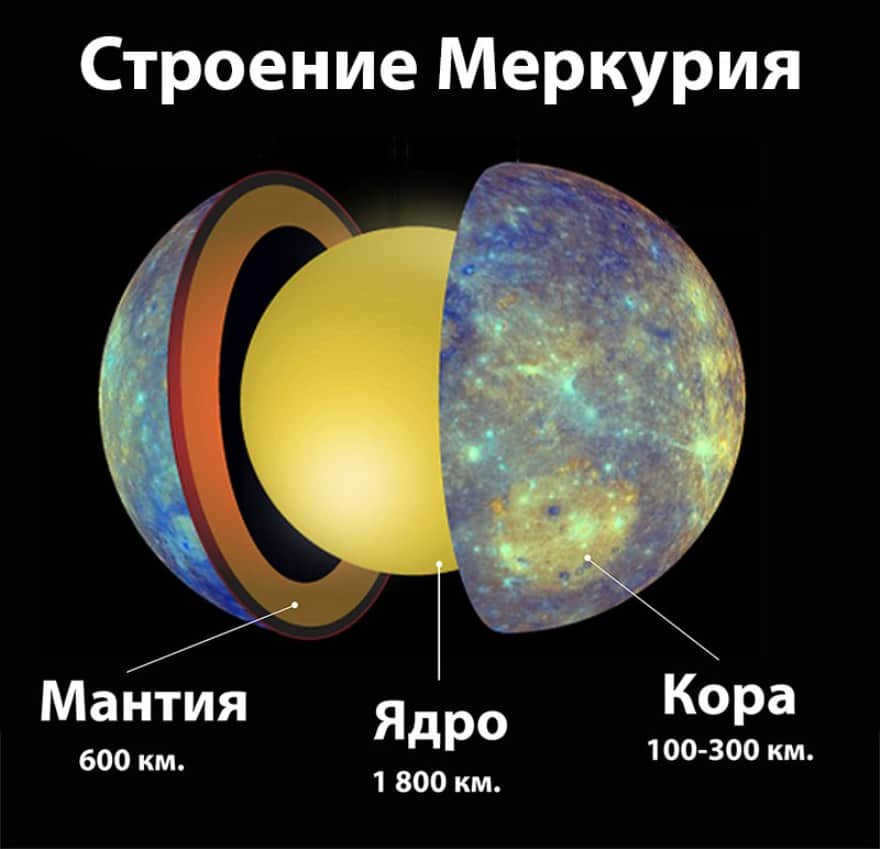
Mercury’s inner makeup
The silicate mantle spans a distance of 500-700 km. Mariner-10 discovered that the crust’s thickness doesn’t exceed 300 km. The core contains a greater amount of iron than any other planet.
The initial mission was only able to map 44% of the surface. Therefore, the missing details were obtained during the MESSENGER spacecraft’s journey.
The Composition of Mercury: The Tilt of its Planetary Axis
Mercury also has a slight tilt away from the ecliptic plane, with a rotation axis tilt of just 2.11 degrees. This minimal tilt has a significant impact on Mercury’s climatic conditions. Tilt refers to the position of a planet in relation to the solar plane. It’s important to note that planets do not align in a straight line, but instead rotate slightly along a curved path. This can even be observed on modern globes.
For comparison, Earth has a tilt of 23.4 degrees, while Uranus has an extreme tilt of 97.8 degrees, giving it the appearance of lying on its side. The axial tilt of a planet affects the change of seasons. However, Mercury remains relatively stable in this regard, with minimal seasonal variations. Additionally, its thin atmosphere does not retain heat well. The side facing the Sun can heat up to 700 K, while the night side cools down to 100 K.
- Fun Facts about Mercury:
- What is the classification of Mercury as a planet?
- Which planet is closest to Mercury in distance?
- What is the estimated age of Mercury?
- Is there any possibility of life on Mercury?
- What is the story behind the discovery of the planet Mercury?
- Who was the first to discover Mercury?
- Has Mercury been visited by humans?
- How did Mercury acquire its name?
- Is it possible to terraform Mercury?
Exploring the position and movement of Mercury
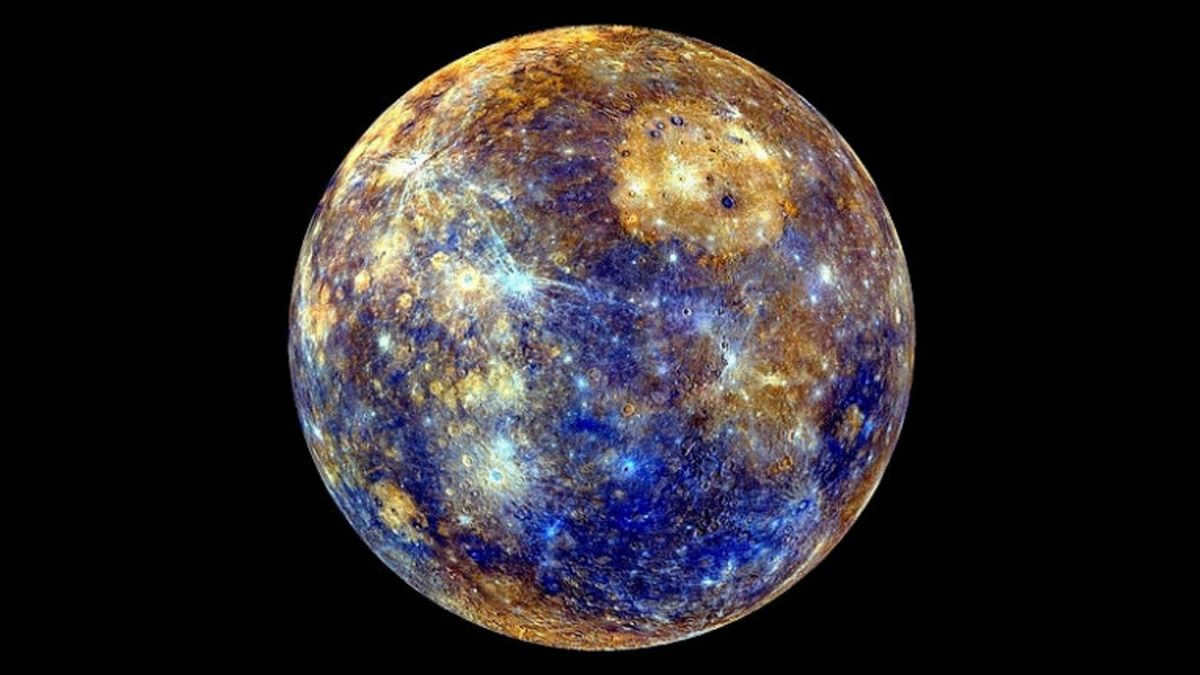
Mercury, the planet closest to the Sun, is a fascinating enigma among the other terrestrial planets. Typically, there is a strong correlation between a planet’s size and its density. However, Mercury defies this pattern by being much denser than expected. Its core is comparable in size to the Moon, which is significantly larger than what would be predicted.
Scientists have been intrigued by this anomaly for years and have been tirelessly working to unravel its mysteries. It is believed that the answer lies in the planet’s formation process.
Mercury remains an enigma due to its close proximity to the Sun, which hampers our ability to study it. Being so near to the Sun, its intense glare obscures our view, making it incredibly challenging to observe and understand this mysterious planet. By unraveling the secrets of Mercury, we could gain valuable insights into the evolution of our solar system. While numerous other celestial bodies have been extensively studied, Mercury has remained elusive, with limited knowledge about its characteristics and composition.
Distinctive Features of Mercury
Dimensions: With a diameter of 4878 kilometers
Weight: 3.33×10²³ kg
Proximity to the Sun: Ranging from 46 million km (Perihelion) to 70 million km (Aphelion)
Distance from our Planet: Varying between 90 million km and 210 million km
Climate: Ranging from -175 °C to 427 °C
Length of a Mercurian day: Equivalent to 176 Earth days
Duration of a Mercurian year: Equivalent to 88 Earth days
Exploratory Missions: Mariner 10, Messenger, Bepicolombo
Physical Appearance: Exhibiting a desolate terrain characterized by craters and fissures.
Mercury possesses such an enigmatic orbit and rotation that it becomes even more enigmatic. Its cycle is incredibly peculiar: a single day on Mercury lasts twice as long as a full Mercurian year!
This bewildering calendar is elucidated by Mercury’s exceedingly sluggish rotation on its axis: during two complete revolutions around the Sun, it only completes three rotations around itself. In simpler terms, and to grasp this peculiarity more effectively, one day on Mercury equates to 176 Earth days. And a year on Mercury lasts merely 88 Earth days! Consequently, a year is shorter than a day.
Mercury’s eccentric orbit results in a massive fluctuation in its proximity to the Sun: from 47 million kilometers to 70 million kilometers.
Mercury’s colossal liquid core was uncovered as a result of its peculiar manner of rotation on its axis. This core is hypothesized to consist of molten iron combined with a small quantity of sulfur.
Mercury possesses an almost negligible atmosphere, comprising a remarkably tenuous exosphere composed of solar particles. Historically, this diminutive celestial body was deemed a relatively unremarkable planet, lacking significant scientific intrigue. However, subsequent to its detection by the inaugural spacecraft, its profile was significantly elevated. While the Egyptians had long recognized and classified Mercury as a planet, comprehensive scrutiny of this enigmatic entity commenced much later, specifically during the mid-1970s when space probes were initially dispatched to its vicinity.
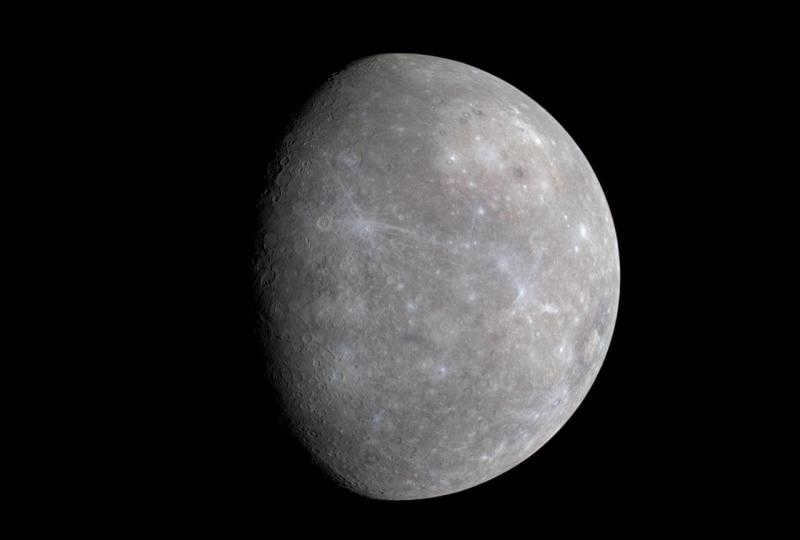
The exploration of Mercury
In 1973, NASA launched Mariner 10, a spacecraft designed to investigate Mercury. This mission marked the first opportunity for humans to observe the enigmatic surface of this planet. The probe captured numerous photographs showcasing a peculiar landscape marked by craters and mountains, and also detected a feeble magnetic field.
Starting from 2011, NASA’s Messenger probe has been creating detailed maps of Mercury’s terrain. It has revealed that Mercury was once teeming with volcanoes, but many questions about the planet remain unanswered.
Researchers are currently attempting to comprehend the composition of the planet, the materials from which it is constructed, and the mechanics behind its magnetic field. Additionally, they are interested in examining the planet’s interaction with the Sun, given its close proximity. All of these factors provide compelling rationales for continuing to dispatch probes to the planet.
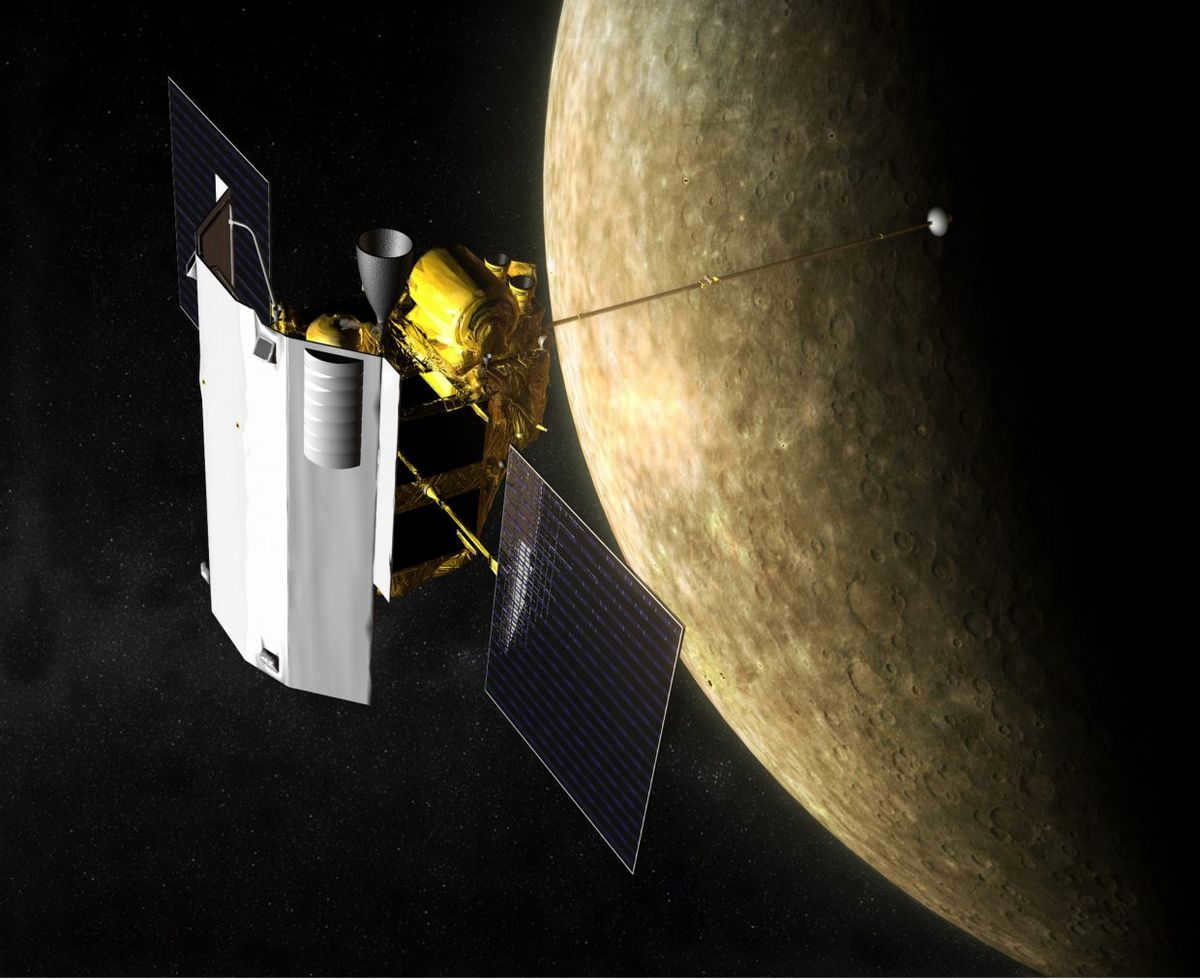
Europa initiated its own mission to Mercury, named Bepicolombo, in October 2018, as a tribute to an Italian mathematician who accurately calculated the trajectory of Mariner 10. The primary obstacle it faces is the overpowering gravitational force of Mercury, and the risk of getting pulled into the Sun, which possesses an incredibly strong gravitational pull. Overcoming this initial obstacle will require meticulous planning and a substantial amount of energy. It will take the probe 6 years and the same amount of energy as a journey to Pluto to reach Mercury!
The objective of Bepicolombo is to become the most comprehensive mission ever undertaken to explore Mercury. The project is being carried out in collaboration with the Japanese space agency. It consists of two probes, each assigned with specific tasks to accomplish.
Conducting a one-year mission, the main objective is to investigate Mercury’s interior, geology, and magnetic field. This mission entails significant risks for the probes, as they will encounter both the intense heat from the Sun and the radiation reflected from Mercury. To ensure safety, the probe is equipped with heaters and heat shields to maintain optimal operating temperatures.
The Planetary Orbiter will revolve around Mercury, with all its instruments directed towards the planet’s surface. This arrangement presents a significant technical challenge, as most of the orbiter’s instruments will be exposed to intense solar radiation. Only one side of the probe, known as the “cold” side, will be directed towards space. This portion of the probe will carry the heat sink and dissipate any excess heat generated during the mission.
The expedition to Mercury, known as Bepicolombo, is scheduled to arrive at its destination in 2025. This mission holds great significance as it not only aims to expand our knowledge about the planet itself, but also seeks to unravel the mysteries surrounding the formation of other rocky planets within our solar system. Moreover, Bepicolombo may even offer valuable insights into the existence of exotelluric planets beyond our celestial neighborhood.
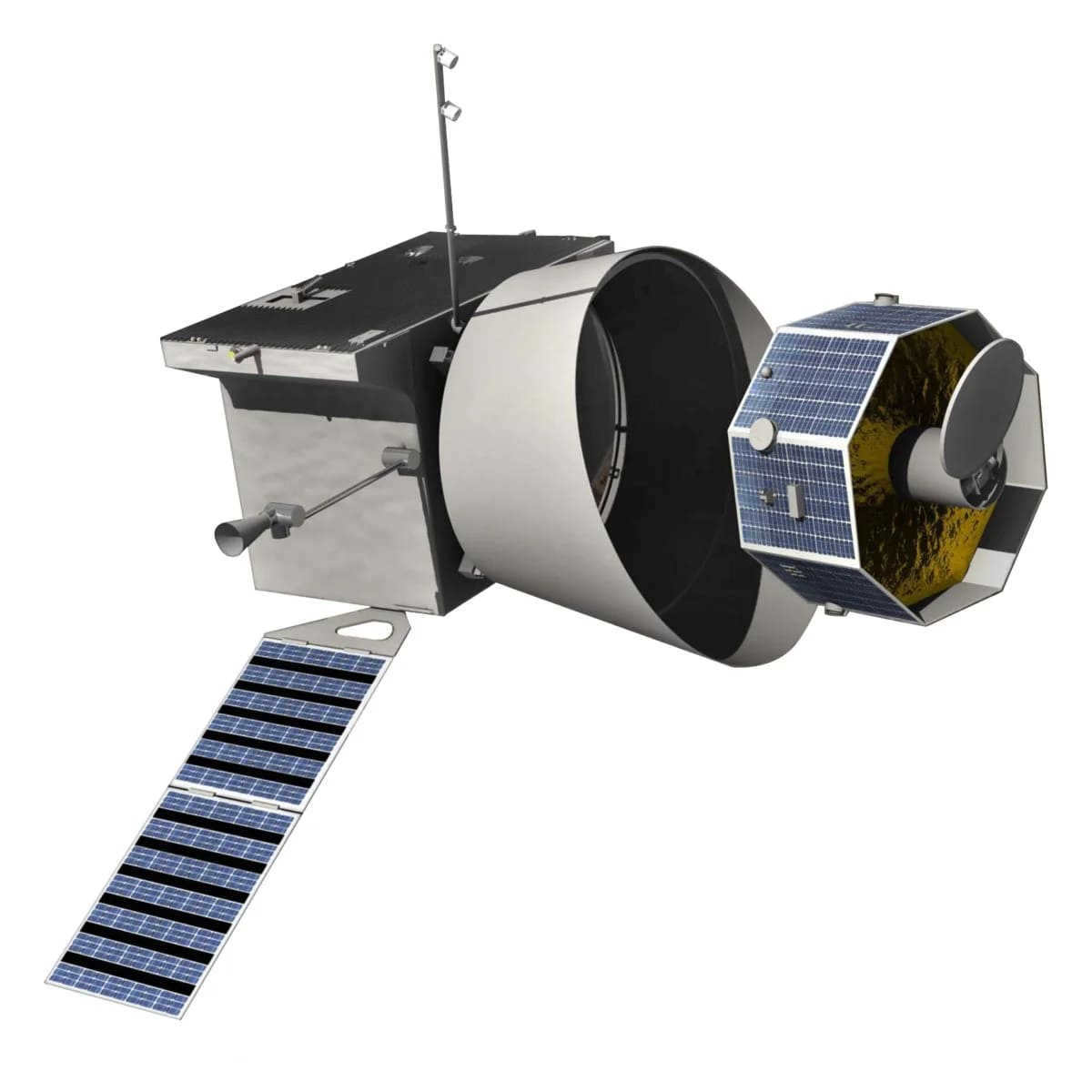
The Enigma of Mercury
For numerous years, a multitude of astronomers have dedicated their efforts to unraveling the mysteries surrounding the creation of exoplanets – celestial bodies that exist beyond our solar system and orbit a distant star. Interestingly, akin to Mercury, a significant number of these exoplanets also closely orbit their respective stars. Hence, by delving into the enigmatic nature of Mercury, scientists are hopeful to glean insights into the formation and proximate positioning of exoplanets.
Scientists worldwide are intrigued by the ever-evolving orbit and rotation of Mercury throughout the ages. This curiosity stems from the fact that other planets in close proximity to their stars exhibit similar behaviors. Consequently, by comprehending the dynamics between the Sun and Mercury, scientists aspire to unravel the complex interplay between a star and its nearest celestial companion.
There exists a solid theory that elucidates the creation of planetary systems. It is grounded in the origin of our solar system. However, what holds true for our solar system may not necessarily hold true for other systems. Mercury poses a unique challenge for scientists, thus it is imperative that we comprehend its formation and evolution in order to gain insight into the formation and evolution of planets beyond our solar system.
Water Discovered on Mercury
Recent findings from the Messenger spacecraft mission have revealed the existence of water on Mercury in the form of ice. Despite the scorching temperatures that dominate the planet’s surface, certain regions that are never exposed to sunlight have been identified as housing solid water. Scientists believe that this water may have been delivered to Mercury by comets. Analysis conducted by the Messenger probe indicates that this water ice is covered with dark carbonaceous elements, which are the same elements that played a role in the origin of life on Earth. Unfortunately, the Messenger probe met its demise on April 30, 2015, as it intentionally crashed into the surface of Mercury.
What causes Venus to be hotter than Mercury?
Despite being closer to the Sun, Mercury is not as hot as Venus. While Mercury has an average temperature of 160 °C, Venus boasts an average temperature of 462 °C. This intriguing phenomenon can be attributed to the presence of an atmosphere. Unlike Mercury, Venus has a robust atmosphere that acts as a heat reservoir. The atmosphere, rich in carbon dioxide, facilitates the greenhouse effect, allowing Venus to trap and retain the heat from the Sun. Consequently, Venus experiences much higher temperatures compared to Mercury.
Is it possible to observe Mercury?
Mercury can be seen with the naked eye and has been visible to humans for many centuries. However, due to its small size and close proximity to the Sun, observing it can be quite challenging. Even when observed through a telescope, very few details can be discerned, making earthly observations of Mercury relatively uninteresting. Nevertheless, when Mercury aligns with the Earth and the Sun, it can be observed using a solar filter.
What is the reason for the abundance of craters on Mercury?
Mercury, similar to other planets in our solar system, has endured a multitude of asteroid impacts. However, unlike Earth, Mercury lacks an atmosphere which serves as a shield against these collisions. Earth’s atmosphere acts as a barrier that largely disintegrates most meteorites that enter our planet’s atmosphere. Additionally, the absence of an atmosphere on Mercury means that there is no erosion taking place. As a result, visible craters have remained intact for approximately 4.5 billion years.
What is the biggest crater on Mercury?
The largest crater on Mercury is called the Caloris Basin, and it measures approximately 1500 km in diameter. Scientists estimate that the asteroid that caused this crater was around 100 km wide. When the asteroid collided with Mercury, seismic waves traveled to the opposite side of the planet, resulting in the rupture of the surface. This event created fascinating rock formations and a chaotic landscape. Within seconds, the craters transformed into hills that were 10 kilometers wide and two kilometers tall. The exact date of this massive impact is unknown, but it is believed to be nearly four billion years old. One thing that is certain is that if a similar impact were to occur on Earth, it would have catastrophic consequences for humanity.
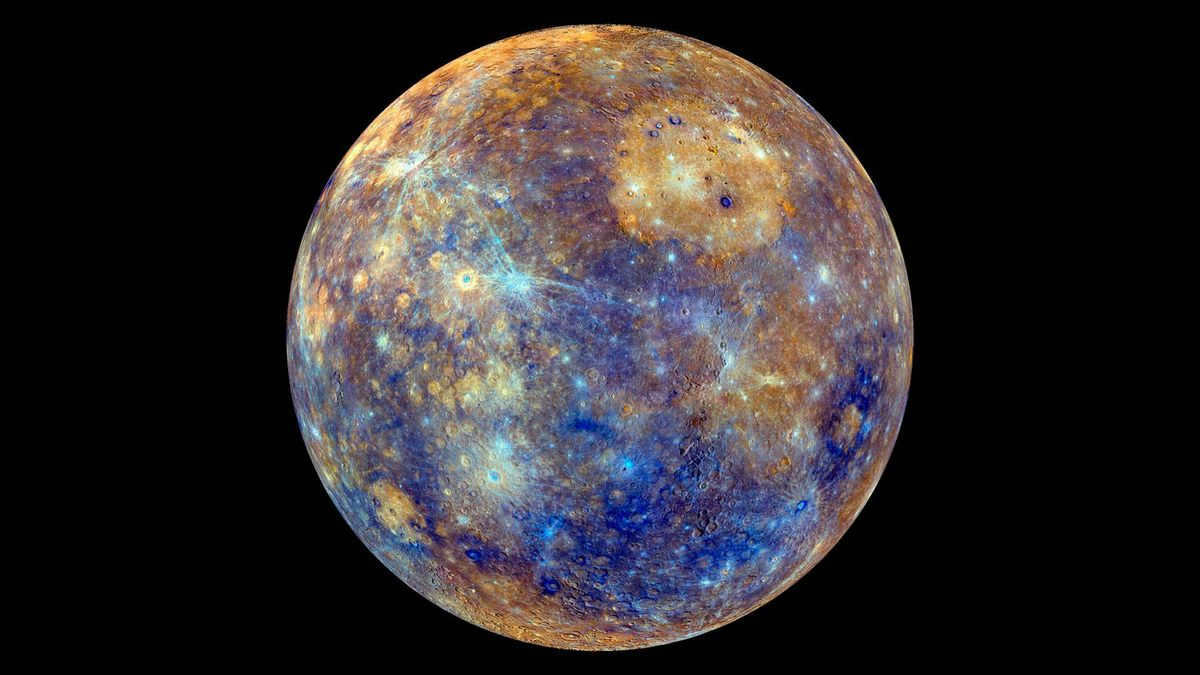
Distinctive Features of Mercury
Mercury is a member of the Earth group of planets. Its apparent magnitude varies from -1.9 m to 5.5 m during different observation periods, although its closeness to the Sun makes it difficult to spot in the sky. Mercury shares similar physical characteristics with Earth’s Moon.
Unlike other planetary bodies in our solar system, Mercury does not have any natural satellites. A local year on Mercury lasts for 88 Earth days. During this time, the planet completes only 1.5 rotations on its own axis. This means that only 3 days pass on Mercury in a span of 2 Earth years.
10 fascinating details about the planet
Mercury orbits the center of the planetary system in an elongated elliptical path. While its rotational speed remains constant, its orbital velocity can fluctuate and even surpass its rotational speed.
Consequently, in the Mercurian sky, the Sun temporarily halts and then moves in the opposite direction, appearing to go from west to east. In certain locations on the planet, observers may perceive the Sun rising and setting twice a day. However, this compilation of intriguing information about Mercury does not conclude here.
Only two spacecraft have explored Mercury
The planet’s location makes it challenging to send research missions to Mercury due to technical difficulties. So far, only 2 spacecraft have been sent to explore it:
- The “Mariner-10” was launched from Earth on November 3, 1973. It flew past Mercury at a distance of approximately 300 km and managed to capture photos of one side of the planet’s surface;
- The “Messenger” was launched on August 3, 2004. It orbited Mercury for over 4 years and conducted a detailed study of its surface.
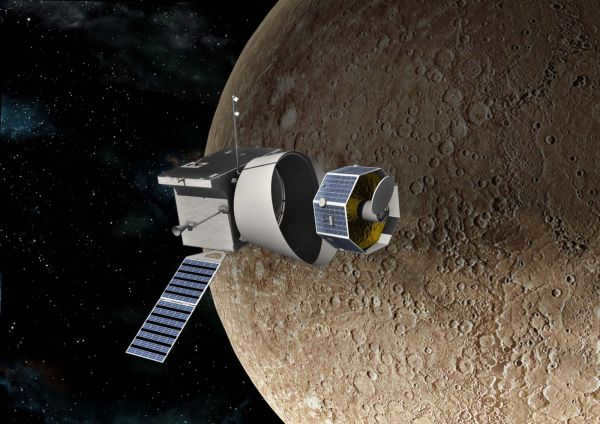
Unknown finder
The first person to observe this celestial object through a telescope was Galileo Galilei. However, the identity of the discoverer of Mercury remains a mystery. References to the planet have been found on clay tablets from the 3rd millennium BC, but it is uncertain if this is the earliest known information. It is possible that Mercury was observed even earlier.
The planet’s name has an interesting history. It was named after the winged god of trade in ancient Rome due to its incredibly fast orbit around the Sun. In ancient Greece, this celestial body was also known as Hermes and Apollo simultaneously. The former name was used when the planet appeared in the evening sky, while the latter was used in the morning. This confusion arose because of Mercury’s high orbital velocity, which led ancient astronomers to believe that there were two different objects in the sky.
Other names for Mercury include:
- “Morning Star” in ancient China;
- “Water Star” in Vietnamese and Japanese;
- “Budha” to the ancient Indians.
The mean separation between Mercury and the Sun is approximately 58 million kilometers. When Mercury is at aphelion, or its farthest distance from the Sun, it moves away from the central star by nearly 70 million km, while at perihelion, or its closest approach, it is only 46 million km away.
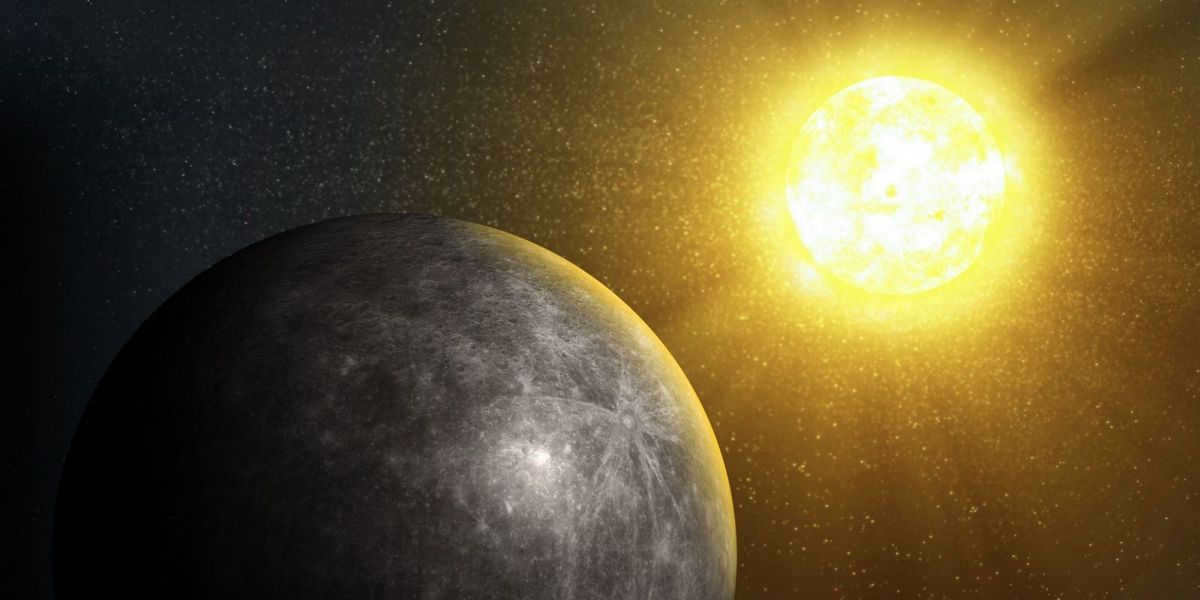
The Sun’s Heating Effects on Mercury
Mercury experiences heat only on its sunlit side, although it can hardly be described as “warm”: the temperature during the day can reach up to +427°C. During the night, the temperature drops to as low as -173°C. These extreme temperature fluctuations make it impossible for life to exist on this planet.
This type of climate occurs daily, as there are no distinct seasons on Mercury due to its nearly vertical position in space: its axis is tilted by a mere 3°.
Mercury is the tiniest planet in the Solar System
The weight of this celestial body is equivalent to 333 quintillion tons (quintillion is a number of 10 to the 18th power, if we employ the short scale of powers of a thousand embraced in our nation), and it makes up merely 5.5% of the corresponding Earth characteristic. Mercury possesses a diameter of 4,880 kilometers.
Density Comparison
With a density of 5.5 g/cm², Mercury is the second most dense planet in our solar system. Only Earth’s solid surface has a higher density than Mercury.
Mysterious Geysers on Mercury
Mercury is home to geysers, which are powerful jets of water vapor that shoot up to the planet’s surface. These geysers can be found in the glaciers located deep within craters. Scientists believe that the ice in these geysers may have been delivered to Mercury by meteorites and comets that collided with the planet in the past.
Mercury is adorned with lofty mountains and extensive crevasses resulting from the fragmentation of the planet. The celestial entity is gradually diminishing in magnitude. The cause of this phenomenon could be attributed to the internal processes occurring within the entity, wherein the core of Mercury, encompassing over 80% of its total volume, is gradually undergoing cooling and contraction.
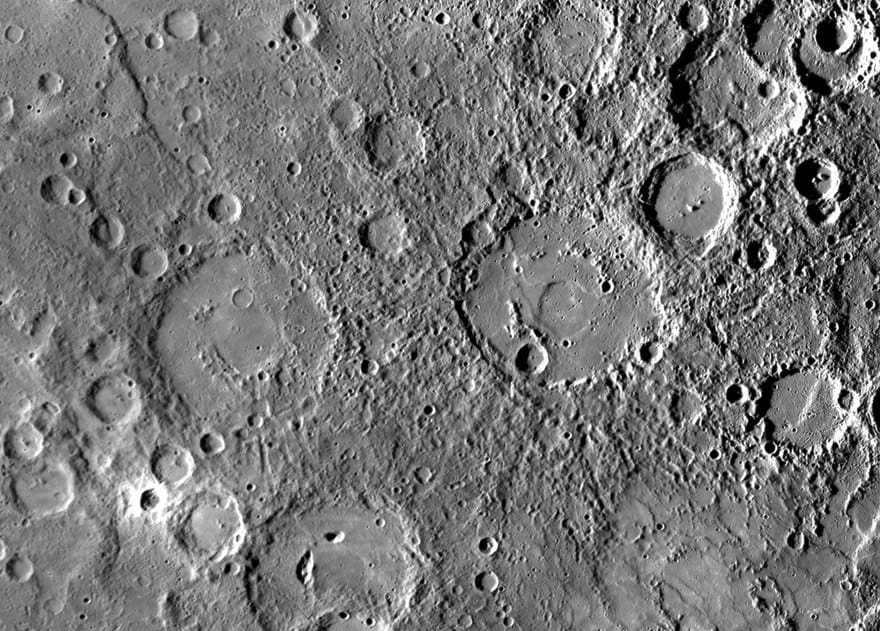

Characteristics of Mercury’s Surface
The surface of Mercury is predominantly rocky and is marked by an abundance of craters. These craters are a result of past collisions with meteorites. Some of these craters, along with their basins, are the largest found within the entire solar system. Notable examples include the Caloris basin, which was discovered in 1974 and has a diameter of 1550 km. Another prominent feature is the “Plain of Heat” crater, which measures 1300 km in cross section. Additionally, there are the “Rembrandt” crater, spanning 716 km, and its neighboring “Beethoven” crater, measuring 625 km in size.
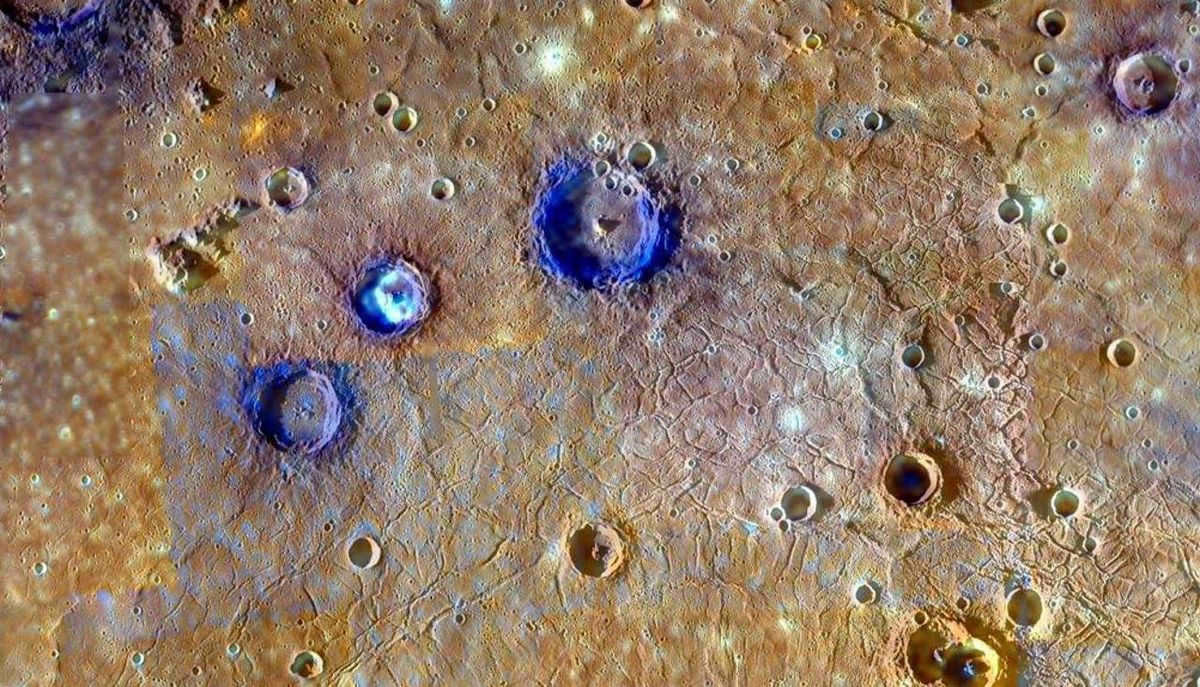
Mercury possesses an atmosphere
The gaseous envelope surrounding the planet takes on the form of a delicate gas “haze” composed of:
- 42% oxygen;
- 29% sodium;
- 22% hydrogen;
- 6% helium;
- 1% various other chemicals in small amounts
Due to its rapid rotation and the influence of the solar wind, Mercury’s weak gravity causes its atmosphere to dissipate quickly into space.
Mercury is the closest planet to the Sun. It is the smallest planet in the Solar System, slightly larger than the Moon and 2.5 times smaller than Earth.

Basic details about Mercury
Mercury is a member of the Earth group and does not have any natural satellites. It possesses a sizable iron-nickel core that accounts for nearly 3/4 of its diameter. The circulation of molten metal within the core generates the conditions necessary for the development of a magnetic field. However, this magnetic field is approximately 100 times weaker than that of Earth.
Mercury completes a full orbit around the Sun in 88 Earth days, while a single day on the planet lasts for 2 Mercurian years. This ratio is highly unusual within the solar system.
With an average velocity of 48 km/s, Mercury follows an exceptionally elongated elliptical orbit that is off-center.
At first glance, the surface of Mercury appears similar to that of the Moon, as it is also covered in craters from comet and meteorite impacts. Additionally, evidence of volcanic activity can be seen, which is characteristic of the early stages of the planet’s formation.
Formation Hypotheses
The prevailing hypothesis regarding the origin of Mercury suggests that it formed from a nebular cloud. Approximately 4.6 billion years ago, after the explosion of a supernova star, the Sun emerged from a gravitationally unstable gas-dust cloud. The condensation of gases around the new star eventually led to the formation of planets, including Mercury.
In the 19th century, a theory emerged proposing that Mercury was originally a moon of Venus but was later lost. This hypothesis helps explain the planet’s unique elliptical orbit.
Another theory suggests that during the early stages of the solar system, there was a tangential collision between Mercury and Venus. This collision caused Mercury to lose a portion of its mantle and crust, with some of the debris being captured by Venus and the rest being scattered throughout space.
There is another interpretation that recounts a scenario where Protomercury collided with a planetesimal that was only one-fifth its mass, resulting in the shedding of a portion of the outer layer of the developing planet. This theory offers an explanation for the unusually large size of its core.
At the heart of Mercury lies its core, which is enveloped by a mantle and a crust. While the Earth has a solid inner core and a liquid outer core, Mercury’s core is continuously in a liquid state. The molten core of the planet has a radius of 1800 km. Surrounding the core is a silicate mantle, with a thickness of approximately 500 km.
Due to the planet’s high eccentricity of orbit and its close proximity to the Sun, a strong tidal effect occurs, causing the matter within the core to circulate.
Previously, it was believed that a celestial body of Mercury’s size could not possess a liquid core. However, radar observations have revealed rotational variations that are atypical for planets with a solid core.
It is quite extraordinary to note the unusually large size of the core of this celestial entity. As a comparison, the center of the Earth constitutes a mere 16% of the celestial body’s volume, whereas the center of Mercury takes up a substantial 70%.
Diverse sources offer different estimates for the thickness of the planet’s solid crust, ranging from 100 to 300 km.
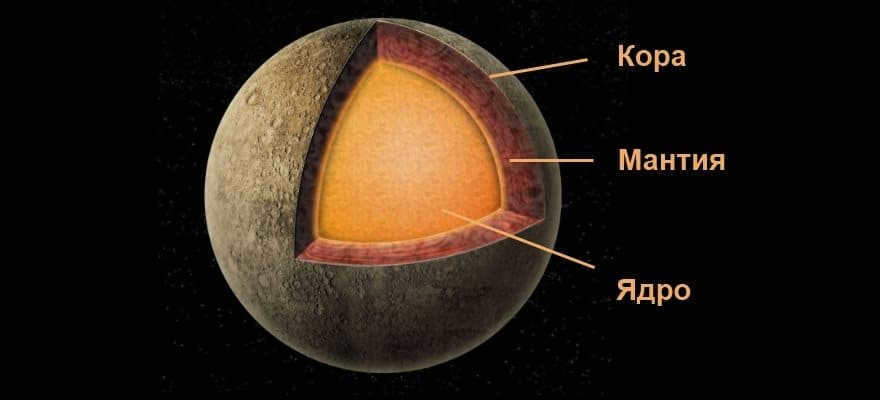
Chemical Makeup
The primary chemical elements comprising the planet consist of iron and nickel, which are in a liquid state and fill the expansive core. Research indicates that the proportion of iron in the core alloy is greater compared to the other planets within the solar system.
The upper layer of the planet does not contain a significant amount of iron; instead, calcium, magnesium, and sulfur dominate. Aluminum is present in small quantities.
The composition of Mercury’s surface can be likened to basaltic rocks found on Earth and the composition of common meteorites known as chondrites.
Despite having a similar elemental content, the average density of Mercury’s upper surface layer is higher than that of meteorites.
Mercury’s Surface
Based on multiple photographs, it can be observed that the surface of Mercury bears a resemblance to the lunar surface, with both being dotted with craters resulting from impacts by smaller celestial bodies. These craters are surrounded by a ring of material that has been ejected from meteorite impacts. The gravitational force on Mercury is greater than that on the Moon, causing the size of these rings on Mercury’s surface to be smaller.
The age of the meteorite impact marks on Mercury varies, with some of them being heavily eroded while others retain their original shape.
One notable difference between Mercury’s surface and the lunar surface is the presence of escarpments, which are rugged ledges on the slopes of mountains. The formation of this type of terrain is attributed to the compression of the crust during the contraction of the planet’s core.
Many volcanoes contributed to the creation of the landscape, with evidence of their activity found in the mountain ranges and plains that were once covered in lava.
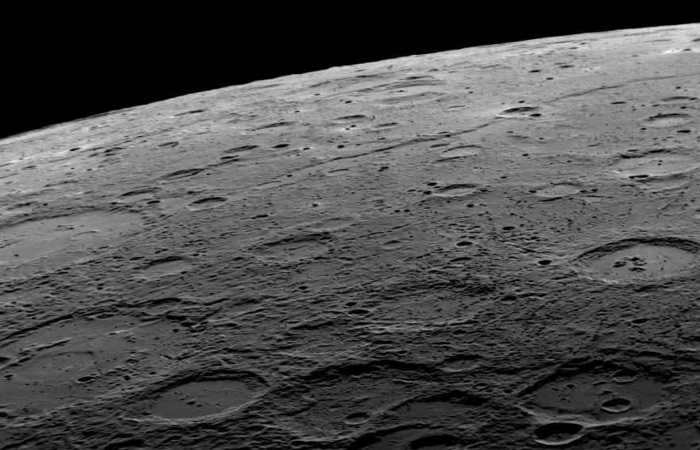
Mercury’s Composition
The main components of Mercury’s temporary atmosphere consist of oxygen, sodium, and hydrogen. Due to the weaker gravitational forces compared to Earth, Mercury is unable to maintain a dense atmosphere. Additionally, its weak magnetic field is unable to retain the atmosphere.
The atmosphere is formed by the solar wind bringing in dust particles from meteorites, gas particles, and radioactive decay products. This results in the formation of a thin and impermanent exosphere above the planet’s surface. This exosphere contains various elements such as oxygen, hydrogen, helium, sodium, potassium, and inert gases. However, these elements are unable to be held by the planet’s gravity and are carried away by the pressure of solar radiation, scattering them into space.
The shredded atmospheric envelope creates a comet-like exospheric trail that extends behind the planet for a distance of 2 million kilometers.
Environmental Conditions
Mercu
The Earth has a slight inclination of its axis of rotation, making it almost impossible for the Sun to reach the poles. Radar studies conducted on these regions have revealed the potential presence of ice on the surface. It is believed that this ice is likely covered with dust and has a thickness of approximately 2 meters.
There is a hypothesis suggesting that these ice deposits were formed as a result of numerous comet impacts. As the water evaporated, it traveled across the planet and accumulated in depressions on the surface, eventually freezing. The existence of ice on Mercury could potentially indicate the possibility of life.
Mercury completes one full rotation around its axis (relative to the center of the Sun) in 176 Earth days, making it the only planet in the solar system with a shorter year than day. The time it takes for Mercury to complete one revolution around the Sun is half of its own days. Mercury has a synodic period of 116 days.
What sets Mercury’s orbit apart is its elongated elliptical shape, which is quite distinct from the more circular trajectories of the other planets.
The average orbital velocity of Mercury is 48 km/s.
During its passage through perihelion, Mercury speeds up to 56 km/s, while at aphelion it slows down to 38.7 km/s. The ratio between its axial rotation and orbital motion near perihelion creates an interesting phenomenon that can be observed from the surface of Mercury, something not seen on Earth: the Sun gradually comes to a halt and then starts moving in the opposite direction.
Magnetism on Mercury
The magnetic field on Mercury is created by the dynamo effect, which is caused by the circulation of molten metal in the planet’s liquid core. Similarly, the Earth also has a magnetic field, but the Earth’s magnetosphere is 100 times stronger than that of Mercury. The magnetic field on Earth forms a magnetosphere that can impact the movement of the solar wind, but it is not powerful enough to retain a stable and dense atmosphere. In contrast, the magnetic field on Mercury is irregular, with large regions of low intensity.
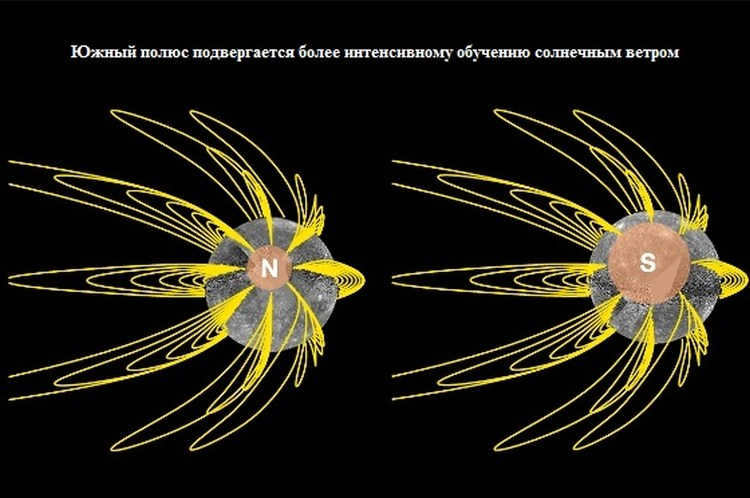
Discovery of Mercury
Mercury has been mentioned in ancient astronomical texts dating back to Babylonian times, and was observed and described as the morning or evening star in Ancient China and Ancient Greece.
The planet has always fascinated scientists, but its study has been challenging due to the difficulties in observing it from Earth. The space age has provided the necessary tools to explore this planet.
Recent explorations of Mercury include:
- In 1974, the American interplanetary spacecraft Mariner 10 made the first close flyby of Mercury, coming within 320 kilometers of its surface. The mission captured numerous photographs of Mercury’s surface and raised suspicions about the presence of ice on the planet.
- In 2004, NASA initiated the launch of the Messenger research spacecraft, which successfully reached Mercury in 2008 and subsequently entered its orbit in 2011. This artificial satellite conducted comprehensive studies on the planet’s atmosphere, surface, and topography, while also analyzing the elemental composition of both the planet and its exosphere. As a result, the first detailed map of Mercury’s surface was meticulously constructed. Unfortunately, in 2015, the probe eventually descended onto the planet’s surface.
- Continuing the exploration of Mercury, a joint mission known as BepiColombo was launched in 2018, combining the scientific modules from both Europe and Japan. These modules are anticipated to reach Mercury in 2025, where they will conduct extensive research on its atmosphere and magnetic field.
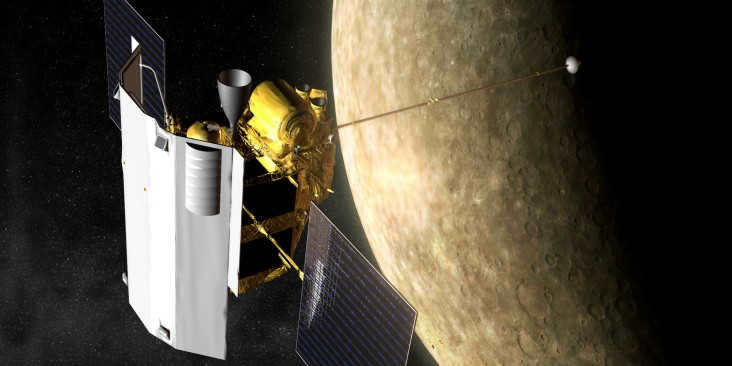
Roscosmos intends to dispatch a spacecraft to carry out the inaugural touchdown on the surface of Mercury, with a launch being readied for 2030.
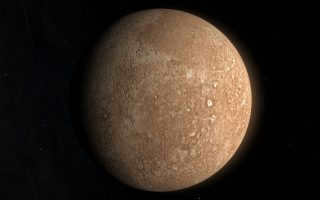
Mercury, the closest planet to the Sun in our solar system, is also the smallest. Its name comes from the ancient Romans, who named it after the god Mercury. In Roman mythology, Mercury was the god of commerce and was known as a messenger of other gods, often depicted wearing winged sandals. This name was chosen for the planet because of its fast movement across the sky compared to other planets.
A Brief Overview
Due to its small size and close proximity to the Sun, observing Mercury from Earth is challenging. As a result, very little was known about the planet for a long time. However, advancements in space exploration, such as the Mariner-10 and Messenger spacecrafts, have provided valuable insights into Mercury. These missions have captured high-quality images and created detailed maps of the planet’s surface, greatly expanding our knowledge of this mysterious world.
Mercury is a member of the Earth group of planets and is located at an average distance of approximately 58 million kilometers from the Sun. Its maximum distance (in aphelion) is 70 million kilometers, while its minimum distance (at perihelion) is 46 million kilometers. With a radius of only slightly larger than that of the Moon, at 2,439 kilometers, and a density almost identical to that of Earth, at 5.42 g/cm³, Mercury contains a significant amount of metals due to its high density. The planet has a mass of 3.3-10 23 kilograms, with approximately 80% of its mass being made up of its core. The acceleration due to gravity on Mercury is 2.6 times less than that of Earth, at 3.7 m/s². It is interesting to note that Mercury is perfectly spherical in shape, with no polar compression, meaning that its equatorial and polar radii are equal. Furthermore, Mercury does not have any satellites.
The Sun’s gravitational pull has caused Mercury’s rotation to slow down, resulting in its rotation period being two-thirds of its orbit around the Sun. This means that one day on Mercury lasts for 176 Earth days, which is twice as long as its year. The reason for this commensurability is the tidal influence of the Sun, which gradually equalized the rotation period with the orbital period.
Mercury has the most elongated orbit among the planets, with an eccentricity of 0.205. It is also inclined at an angle of 7 degrees to the plane of the Earth’s orbit (ecliptic plane). The planet travels at a velocity of 48 km/s along its orbit.
The temperature of Mercury was determined by analyzing its infrared radiation. It exhibits a wide range of temperatures, ranging from 100 K (-173 °C) at the night side and poles to 700 K (430 °C) at midday at the equator. Additionally, as one goes deeper into the crust, the diurnal temperature fluctuations decrease rapidly, indicating that the ground has a high thermal inertia. This suggests that the surface of Mercury is covered by regolith, a type of fragmented rock with low density. It is worth noting that regolith is also present on the surface layers of the Moon, Mars, and its satellites Phobos and Deimos.
Formation of Planets
The most likely explanation for the birth of Mercury is the nebular hypothesis, suggesting that the planet was once a moon of Venus before breaking free from its gravitational pull. Another theory suggests that Mercury formed alongside other objects in the solar system within the inner part of the protoplanetary disk, with lighter elements being carried away by the solar wind to the outer regions.
Following the completion of its initial formation stage approximately 4.6 billion years ago, Mercury experienced a prolonged period of intense bombardment by comets and asteroids, resulting in the formation of numerous craters on its surface. Additionally, early in its history, the planet underwent significant volcanic activity, which gave rise to lava plains and enclosed “seas” within the craters. As Mercury gradually cooled and contracted, a variety of other landforms emerged including ridges, mountains, hills, and escarpments.
Structure of Mercury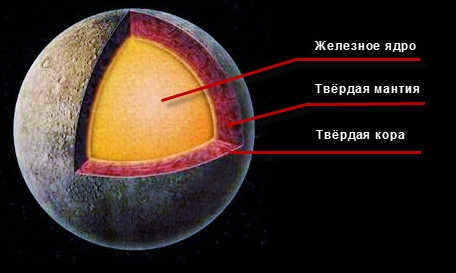
The overall internal structure of Mercury is similar to that of other terrestrial planets in the Solar System. It consists of a central core made of metal, which has a radius of approximately 1800 km. This core is surrounded by a mantle layer that is about 500 – 600 km thick. The mantle is then covered by a crust, which is between 100 – 300 km in thickness.
Previously, it was believed that the core of Mercury was solid and constituted approximately 60% of its overall mass. The rationale behind this assumption was that a planet of such small size could only possess a solid core. However, the existence of the planet’s own magnetic field, albeit weak, provides compelling evidence in support of the theory that its core is actually liquid. The movement of material within the core generates a dynamo effect, while the significant elongation of the planet’s orbit induces a tidal effect that maintains the core in a liquid state. It is now firmly established that Mercury’s core is composed of liquid iron and nickel, accounting for three quarters of the planet’s mass.
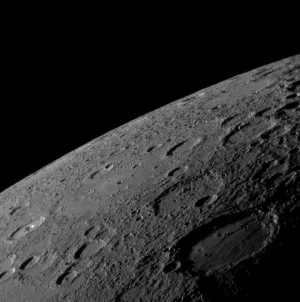
The surface of Mercury bears a striking resemblance to that of the moon. One of the most prominent similarities is the abundance of craters, both large and small. Similar to the moon, there are bright rays of light emanating from the younger craters on Mercury. However, unlike the moon, Mercury does not have vast seas, which are also relatively smooth and devoid of craters. Another distinctive feature of Mercury’s landscape is the presence of numerous scarps that stretch hundreds of kilometers, a result of the planet’s shrinking.
The largest crater on Mercury measures approximately 1,500 kilometers in diameter and reaches a height of 2 kilometers. Inside this crater lies a vast expanse of molten rock known as the Heat Plain. This feature stands out as the most prominent aspect of the planet’s surface. The impact that created such a massive formation must have involved a celestial body at least 100 kilometers in length.
Images captured by the probe reveal a uniform surface on Mercury, with no noticeable differences in relief between its hemispheres. This sets it apart from both the Moon and Mars. The composition of the surface also differs significantly from that of the Moon, with fewer traces of aluminum and calcium but a notable abundance of sulfur.
Composition of the Atmosphere and Magnetic Field on Mercury
The atmosphere of Mercury is extremely sparse and almost non-existent. Its density is comparable to that of Earth’s atmosphere at an altitude of 700 kilometers. The exact composition of the atmosphere is still uncertain, but spectroscopic studies have provided some insights. It has been discovered that the atmosphere of Mercury contains significant amounts of helium and sodium, along with traces of oxygen, argon, potassium, and hydrogen. These elements are believed to be either brought in from outer space by the solar wind or captured from the planet’s surface. Radioactive decay in the planet’s crust is thought to be a source of helium and argon. The presence of water vapor can be attributed to various factors such as the formation of water from hydrogen and oxygen present in the atmosphere, the impact of comets on the planet’s surface, and the sublimation of ice, potentially located in craters at the poles.
The magnetic field of Mercury is relatively weak, measuring just 100 times less at the equator compared to Earth. Despite this, the planet still manages to generate a strong magnetosphere. The axis of the field closely aligns with the rotational axis and is estimated to be around 3.8 billion years old. As a result of its interaction with the solar wind surrounding it, Mercury experiences vortices that are 10 times more frequent than those observed in Earth’s magnetic field.
Observing Mercury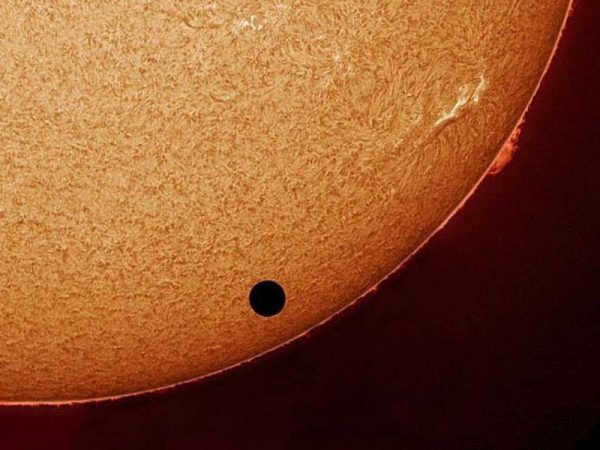
As previously mentioned, the observation of Mercury from Earth poses a significant challenge. Due to its proximity to the Sun, it is never more than 28 degrees away and thus is practically invisible. The visibility of Mercury varies depending on one’s geographic latitude. It is most easily observed at the equator and latitudes near it, as the duration of twilight is shortest in these regions. At higher latitudes, Mercury becomes much more difficult to spot, as it appears very low above the horizon. The optimal conditions for observation occur when Mercury is at its greatest distance from the Sun or when it is at its highest altitude during sunrise or sunset. Additionally, the equinoxes offer a favorable opportunity for observation, as the duration of twilight is minimal during these periods.
Observing Mercury through binoculars shortly after sunset is quite simple. Its phases can be easily seen through a telescope with a diameter of 80 mm. However, surface features can only be observed with much larger telescopes, and even then it can be quite challenging.
Did you know?


